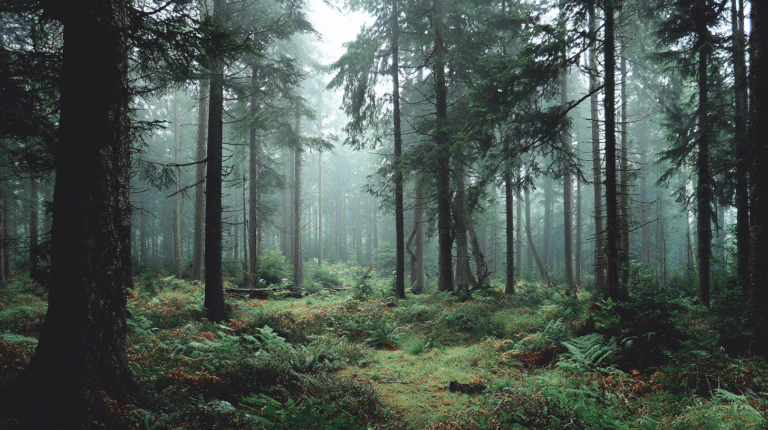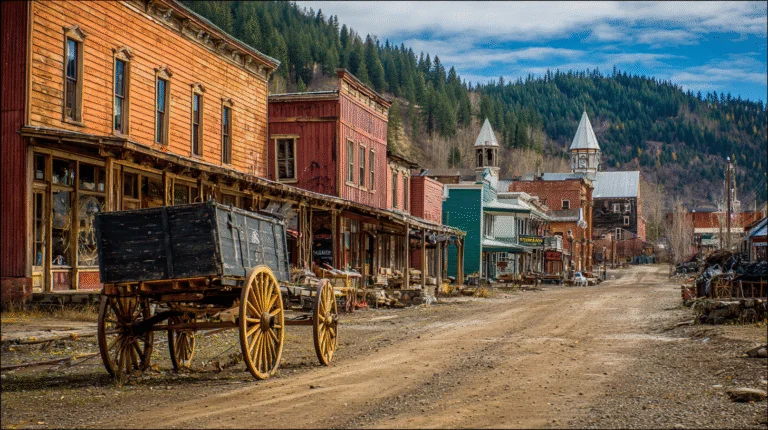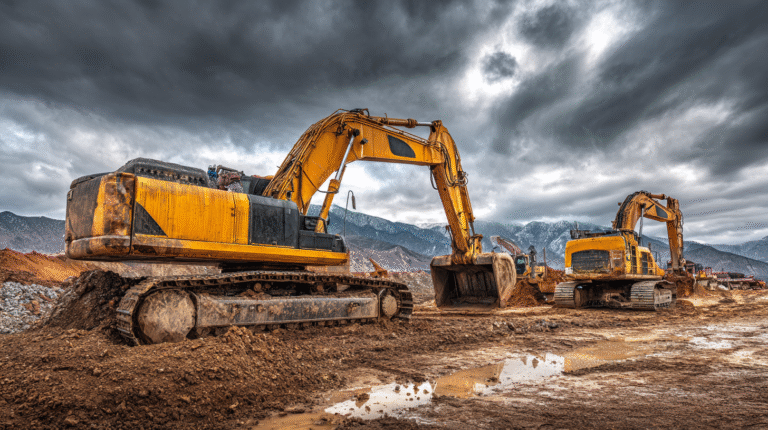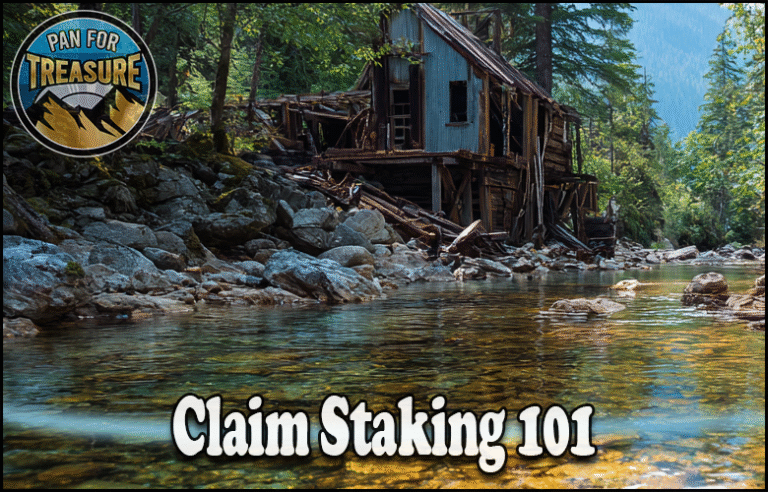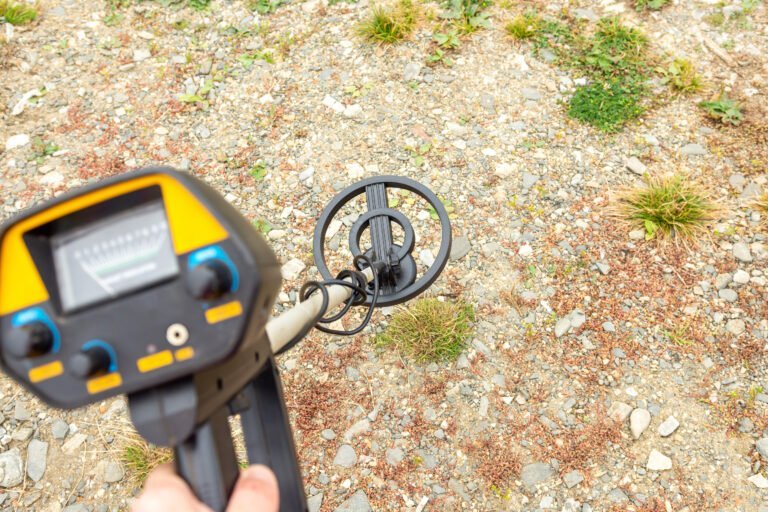
Disclosure: This Post Contains Affiliate Links; We earn a commission on purchases.
Welcome to our guide on gold mining claims! If you’ve ever dreamed of securing your own piece of the gold rush, understanding claim staking and ownership rights is crucial.
In this article, we’ll explore the ins and outs of mining claims, the types of minerals found on federal lands, and the process of staking a claim.
When it comes to gold mining claims, there are three types of minerals: locatable, leasable, and salable.
Locatable minerals include metallic and nonmetallic minerals, with lode and placer claims being the two main types.
Lode claims are for well-defined mineral deposits, while placer claims cover all other deposits. It’s important to know the specific laws and regulations in your state, as requirements can vary.
Understanding the different claim types, such as lode and placer claims, is essential.
Lode claims are ideal for classic veins or rock bearing valuable minerals, while placer claims are for deposits not located within a lode claim.
The size limitations and requirements also vary depending on the claim type, so it’s crucial to familiarize yourself with the regulations.
Now, let’s dive into the process of staking a claim. Staking a claim is the legal process of claiming the right to extract minerals from a designated area of public land.
The Bureau of Land Management (BLM) and the US Forest Service manage federal lands for mining purposes.
However, it’s worth noting that in some cases, it may be possible to stake a claim on private land with the landowner’s permission.
Once you’ve identified an area of interest and conducted the necessary research, it’s time to stake your claim.
This involves marking the boundaries of your claim and filing a Notice of Location within the given time frame.
It’s important to follow state regulations, pay the required fees, and stay on top of annual maintenance fees to keep your claim active. Failure to do so can result in the claim becoming inactive.
Staking a mining claim on federally administered land, such as that managed by the Bureau of Land Management or the Forest Service, is common practice.
However, it’s crucial to avoid areas that are withdrawn from mining claims, such as national parks and monuments.
If you are considering staking a claim on private land, obtaining permission from the landowner is essential.
The cost of owning a mining claim is relatively low, thanks to the General Mining Act of 1872. The act set the price per acre at $2.50-$5.
However, it’s important to note that owning a claim grants you mineral rights, not ownership of the land itself.
The claim is an annual lease between you and the federal government, and the price and regulations may vary based on the location and claim type.
Prospecting for gold is an exciting part of the process. By identifying potential areas for mineral extraction, using basic tools such as a gold pan and shovel, and understanding the geological characteristics of gold deposits, you can enhance your chances of success.
In conclusion, securing and owning a mining claim requires careful consideration of claim staking procedures, adherence to state and federal regulations, and thorough research. By following the proper steps and conducting due diligence, you can secure your right to extract valuable minerals and potentially benefit from the gold rush. Stay tuned for our upcoming sections where we’ll delve deeper into the intricacies of claim staking and provide you with a step-by-step process to help you navigate the world of gold mining claims.
Understanding Claim Types: Lode and Placer Claims
When it comes to gold mining claims, there are two main types to consider: lode claims and placer claims. Both claim types offer opportunities for prospecting and extracting valuable mineral deposits, but understanding the differences between them is essential for successful mining ventures.
The Basics: Lode Claims
Lode claims are specifically for classic veins or rock formations that contain valuable minerals. These claims are typically associated with well-defined mineral deposits and are often located in hard rock or quartz veins. Lode claims can be limited in size, depending on the specific regulations of the state or area.
One of the key advantages of lode claims is that they can support mining operations. These operations involve extracting ore from the veins by drilling, blasting, and processing the material through mills or reduction works. Lode claims commonly require more extensive mining infrastructure and processes compared to placer claims.
The Basics: Placer Claims
Placer claims, on the other hand, are meant for mineral deposits that are not associated with a lode claim. These claims cover potential gold-bearing deposits that originated from weathering and erosion processes. Unlike lode claims, placer claims do not require the presence of well-defined veins.
One of the key advantages of placer claims is that they do not require the use of mills or reduction works. This makes them more accessible to individual miners and small-scale operations. Placer claims can cover larger areas, often up to 20 acres per locator, providing ample space for potential mining activities. However, it’s important to note that the size for corporations is limited as per specific rules and regulations.
Placer claims involve extracting gold through various methods such as panning, sluicing, or dredging. These techniques rely on the natural processes of gravity and water to separate the heavier gold particles from the surrounding material.
Understanding Mineral Deposits
Both lode claims and placer claims can lead to the discovery of valuable mineral deposits. Mineral deposits are naturally occurring concentrations of minerals within the Earth’s crust. Gold deposits can vary in size and quality, and their formation is influenced by various geological processes.
It’s critical for miners to understand the characteristics of mineral deposits and their associated geological features. This knowledge helps prospectors identify potential areas for claim staking and increases the chances of finding valuable gold deposits.
| Claim Type | Key Features | Advantages |
|---|---|---|
| Lode Claims | Classic veins or rock formations with valuable minerals | Support mining operations Opportunity for higher-grade ore |
| Placer Claims | Deposits not associated with lode claims; formed through weathering and erosion | No requirement for mills or reduction works Accessible to individual miners |
When staking a mining claim, it’s crucial to consider the specific regulations and requirements for each claim type. By understanding the characteristics of lode claims and placer claims, miners can make informed decisions and increase the chances of securing valuable mineral deposits.
The Process of Staking a Claim
Staking a claim is a crucial step in the process of securing mining rights and extracting valuable minerals. This legal process involves claiming the right to extract minerals from a designated area of land. The majority of mining claims are staked on public lands, which are typically managed by the Bureau of Land Management (BLM) or the US Forest Service. However, in some cases, it may also be possible to stake a claim on private land with the permission of the landowner.
Before commencing any mining activities on a claim, it is important to consider the pertinent regulations and obtain the necessary permits. Different activities may require additional requirements and permits, which must be thoroughly researched and adhered to in order to avoid any legal complications.
When staking a claim, it is essential to understand and comply with claim regulations. These regulations outline the specific procedures and requirements for staking a claim, as well as the ongoing obligations to maintain and renew the claim.
“Staking a claim is the first step towards securing mining rights and accessing mineral resources. It is crucial to navigate the claim regulations diligently to ensure compliance and protect your ownership rights.”
Public Land vs. Private Land
The majority of mining claims are staked on public lands, which are owned and managed by the federal government. These lands offer vast opportunities for mineral extraction and are subject to specific regulations set by the BLM and the US Forest Service.
Staking a claim on private land is less common but may be possible with the landowner’s permission. In such cases, it is essential to establish a clear agreement and ensure compliance with both state and federal regulations governing the extraction of minerals on private properties.
Understanding Claim Regulations
Claim regulations play a vital role in securing and maintaining mining rights. These regulations vary by jurisdiction and can impact the process of staking, holding, and renewing a claim. It is crucial to thoroughly research and understand the specific regulations applicable to the area where you intend to stake a claim.
Some common claim regulations cover:
- Claim size limitations
- Boundaries and monuments
- Notice of location requirements
- Filing fees and deadlines
- Annual maintenance fees
- Accessibility and presence requirements
Complying with claim regulations is essential to protect your ownership rights and ensure a secure piece of the gold rush. Failure to adhere to these regulations can result in the loss of your claim and potential legal consequences.
https://www.youtube.com/watch?v=1OSzRh1Da74
| Benefits of Staking on Public Land | Considerations for Staking on Private Land |
|---|---|
|
|
How to Stake a Mining Claim
Staking a mining claim is the crucial first step in securing your rights to mineral extraction. Whether you’re interested in a lode claim, placer claim, mill site, or tunnel claim, the process requires careful navigation of specific procedures and regulations. Follow these steps to successfully stake your mining claim:
Finding Your Area of Interest
Begin by identifying an area that holds potential for valuable mineral deposits. This could be based on historical records, geological surveys, or personal research. Conduct a land status search to ensure the area is available for a claim and not already under a lease or withdrawn from mining.
Mapping Your Location
Once you’ve selected your area of interest, map out the precise boundaries of your claim. This is essential for determining the exact extent of your mining claim and staying within legal limits.
Determining the Claim Type
Decide which type of claim is most applicable to your situation. Is it a lode claim, where mineral deposits are found within rock formations? Or is it a placer claim, where minerals are present in loose materials such as sand or gravel? Understanding the claim type is crucial for compliance and the subsequent extraction process.
Staking the Ground
Next, physically stake the ground to mark the boundaries of your claim. This involves placing durable monuments at each corner of your claim, following state-specific regulations and guidance. The monuments serve as clear indicators of your claim’s extent and help prevent any encroachments.
Filing a Notice of Location
Once you have staked the ground, file a Notice of Location within the designated timeframe specified by the relevant authorities. This notice provides detailed information about your claim, such as its coordinates, size, and type. Submitting this notice is crucial for establishing your right to the claim and informing others of your mining intentions.
Paying the Required Fees
Along with filing the Notice of Location, make sure to pay the necessary fees associated with staking and maintaining your mining claim. These fees can vary depending on the jurisdiction and claim type, but they are essential for keeping your claim active and legally recognized.
Remember, failure to pay annual fees can result in the claim becoming inactive, potentially opening up the area for others to stake. Stay proactive and ensure your claim remains in good standing by fulfilling all financial obligations.
Staking a mining claim involves careful consideration of the area of interest, thorough land status search, claim type determination, proper staking of the ground, timely filing of the Notice of Location, and payment of the required fees. By following these steps, you can secure your mining rights and embark on your journey to extract valuable minerals.
Where to Stake a Mining Claim
When it comes to staking a mining claim, federally administered land is the most common choice. This includes areas managed by the Bureau of Land Management (BLM) and Forest Service land under the management of the United States Department of Agriculture. Some of the states where federally administered land is available for mining claims include Alaska, Arizona, California, Colorado, Nevada, and Wyoming, among others.
The Bureau of Land Management is responsible for managing the surface of public land, while the Forest Service oversees the surface of National Forest System land. These agencies play a crucial role in regulating and granting mining claims on their respective lands.
However, it’s important to note that there are certain areas that are withdrawn from mining claims. These include national parks, national monuments, and other protected areas that are off-limits for mining activities. It’s essential for claimants to respect these withdrawn areas and avoid staking claims there.
In addition to federally administered land, claimants can also consider staking a claim on private lands. However, prior permission must be obtained from the landowner before proceeding with any mining activities on private property.
To summarize, the key locations for staking a mining claim are federally administered land, with the Bureau of Land Management and Forest Service playing critical roles in managing these areas. Claimants should adhere to regulations and avoid withdrawn areas like national parks. Permission from landowners is necessary for staking a claim on private lands.
Important Dates for Claim Staking
Once you have located and recorded a mining claim, there are important dates and actions you need to be aware of to maintain your claim and comply with regulations.
Filing the Location Notice
After locating and recording a mining claim, you must file a location notice with the proper state Bureau of Land Management (BLM) office within a specific time frame. This notice serves as an official record of your claim and must also be filed with the county recorder’s office or borough office.
Annual Maintenance and Assessment
To keep your mining claim active, annual maintenance fees must be paid by September 1 each year. These fees contribute to the ongoing management and regulation of mining claims. Failure to pay the fees on time can result in the claim becoming inactive.
Small Miner’s Waiver
If you are a claimant with fewer than 10 mining claims, you may be eligible for a Small Miner’s Waiver. This waiver allows you to waive the annual maintenance fee for one mining claim of your choice. It provides an opportunity for small-scale miners to reduce the financial burden associated with multiple claims.
Notice of Intent for Mill or Tunnel Sites
If you own a mill or tunnel site, it is important to file a notice of intent to hold the site by December 30. This notice ensures that your ownership rights to the mill or tunnel site are maintained and recognized by the relevant authorities.
Summary of Important Dates
| Important Dates | Actions |
|---|---|
| Filing the Location Notice | File with state BLM office and county recorder’s office/borough office |
| Annual Maintenance and Assessment | Pay fees by September 1 each year |
| Small Miner’s Waiver | Apply if eligible for waiver |
| Notice of Intent for Mill or Tunnel Sites | File by December 30 |
The Cost of Owning a Mining Claim
The cost of owning a mining claim is relatively low, thanks to the General Mining Act of 1872. Under this act, the price of a mining claim is set at $2.50-$5 per acre. It is important to note that this price has remained unchanged since the act was put into place.
However, it is crucial to understand that owning a mining claim does not grant ownership of the land itself. Instead, it grants the mineral rights to the land. The claim serves as an annual lease agreement between the claimant and the federal government.
The price of a mining claim and the specific regulations surrounding it may vary depending on the location and type of claim. It is essential to thoroughly research and understand these regulations before staking a claim.
To provide a clear overview of the costs associated with owning a mining claim, the table below outlines the prices set by the General Mining Act of 1872 for different claim sizes:
| Claim Size | Price per Acre |
|---|---|
| Lode Claim | $2.50 – $5 |
| Placer Claim | $2.50 – $5 |
| Mill Site Claim | $5 |
| Tunnel Site Claim | $5 |
It is important to note that the prices listed in the table are subject to change based on any future amendments to the General Mining Act of 1872 or specific regulations implemented by governing authorities.
By understanding the cost of owning a mining claim, individuals can make informed decisions and effectively navigate the process of securing their mineral rights.
Prospecting for Gold
When it comes to finding gold, prospecting is the key. By exploring potential areas where gold deposits may be present, you can increase your chances of striking it rich. One of the first steps in the prospecting process is to consult historical records and reports, which provide valuable insights into previous gold discoveries and mining activities in the area.
Basic tools such as a gold pan and a trusty shovel are essential for prospectors. The gold pan is used to gather material from the ground, while the shovel helps in excavating and collecting samples. These simple yet effective tools allow prospectors to get up close and personal with the earth, sifting through sediments and searching for that elusive glimmer of gold.
Once you have gathered material, the next step is to pan it. This process involves carefully swirling the material in the gold pan, allowing the heavier gold particles to sink to the bottom while lighter materials are washed away. By practicing proper panning techniques, prospectors can separate the gold from other substances and start their treasure hunt.
Identifying gold specks or flakes can be an exciting moment for prospectors. These tiny but valuable traces indicate the presence of gold in the area. The ability to recognize these precious specks requires a keen eye and some practice. Familiarizing yourself with the geological characteristics of gold deposits and studying the history of gold mining in the region can provide valuable insights and help refine your prospecting skills.
Remember, prospecting for gold is not just about luck; it’s about employing various techniques, using the right tools, and having a solid understanding of geological conditions. So grab your gold pan, pick up your shovel, and embark on a thrilling journey to uncover nature’s golden treasures.
Staking and Filing a Claim: The Step-by-Step Process
When it comes to staking and filing a mining claim, following the correct procedures is essential. Understanding the staking process, monument requirements, filing a notice of location, claim fees, and BLM records is crucial for a successful claim. Here is a step-by-step guide to help you through the process:
1. Staking the Claim
The first step in staking a mining claim is to locate the area where you want to stake your claim. Once you have found the desired location, you will need to mark the boundaries of your claim with monuments placed at each corner. Each state may have specific requirements regarding monument size and material. It’s important to adhere to these regulations to ensure your claim is valid.
2. Filing a Notice of Location
After staking the claim, you need to file a notice of location to officially establish your claim. This notice must be filed within a specific timeframe and includes detailed information about the claim and its location. It is crucial to accurately provide all the necessary data to avoid any discrepancies or issues with your claim.
3. Paying Claim Fees
Claim fees play a crucial role in keeping your claim active. You need to pay these fees regularly to maintain your claim’s validity and prevent it from becoming inactive. The specific fee amounts and payment frequencies may vary depending on the location and type of claim. It is important to stay updated on the relevant regulations and deadlines to ensure your claim remains active.
4. Checking BLM Records and On-Site Inspections
Before finalizing your claim, it is advisable to check the Bureau of Land Management (BLM) records. This will help you verify whether there are any prior claims on the land you intend to stake. On-site inspections can also provide valuable insights into the viability of your claim and any potential challenges or opportunities associated with it.
By following these step-by-step procedures and understanding the staking process, monument requirements, filing a notice of location, claim fees, and BLM records, you can increase your chances of successfully staking and filing a mining claim. It is vital to conduct thorough research, adhere to all regulations, and seek expert advice to ensure a smooth and legally compliant claim process.
| Process | Description |
|---|---|
| 1. Staking the Claim | Locate the area Place monuments at each corner Adhere to monument requirements |
| 2. Filing a Notice of Location | File the notice within the given timeframe Provide accurate claim and location information |
| 3. Paying Claim Fees | Regularly pay the required fees Stay updated on fee amounts and deadlines |
| 4. Checking BLM Records and On-Site Inspections | Verify prior claims on the land Gain insights through on-site inspections |
Conclusion
Securing and owning a mining claim involves understanding the mining claim process, following state and federal regulations, and conducting thorough research. By properly staking and filing a claim, individuals can secure their rights to mineral extraction and potentially benefit from valuable mineral deposits. However, it is crucial to carefully consider the specific requirements and fees associated with mining claims to ensure compliance with legal obligations.
One of the key aspects of securing mining rights is conducting due diligence. This involves thoroughly researching the area of interest, including the geological characteristics and historical mining activities. By gathering as much information as possible, prospective claimants can make informed decisions and increase their chances of success.
It is also important to stay updated on any changes in laws or regulations related to mining claims. As regulations may vary by state and federal agency, staying informed will help claimants navigate the legal requirements effectively. Seeking expert advice can also provide valuable insights and guidance throughout the process.
Source Links
- https://www.blm.gov/programs/energy-and-minerals/mining-and-minerals/locatable-minerals/mining-claims
- https://www.rangefront.com/blog/how-to-stake-a-mining-claim
- https://chiangku.medium.com/how-to-stake-a-mining-claim-aa2f83fe2c06

Meet Ryan Conlon, the passionate owner and driving force behind Pan for Treasure.
With an unwavering love for the art of gold panning, Ryan has transformed his enthusiasm into a thriving community hub for fellow treasure seekers. info@panfortreasure.com
A seasoned gold panning enthusiast, Ryan’s journey began with a simple pan and a dream, evolving into a deep appreciation for the history, geology, and thrill of uncovering precious metals.
Subscribe to Our Newsletter

